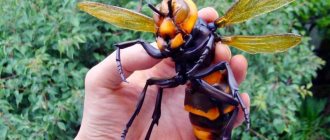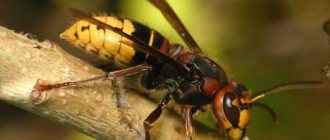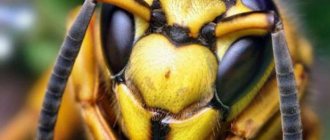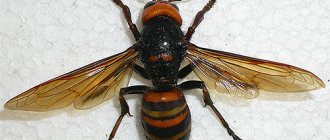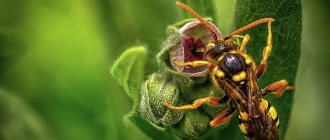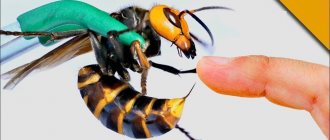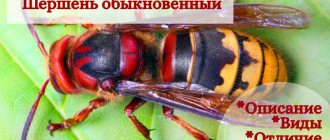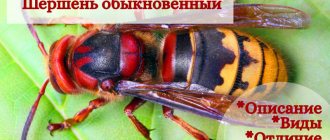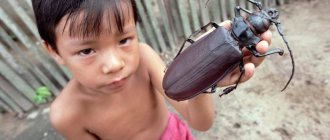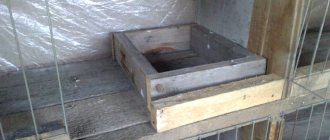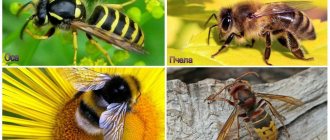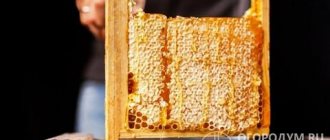- Wild animals
- >>
- Insects
We are surrounded by many interesting insects, among which the hornet .
These creatures have a very bright appearance, are quite large in size, and are excellent hunters of small pests. People don't hold hornets in high esteem. This is not surprising, because they can sting painfully, and their poison in large quantities can even lead to death. However, animals pose a great danger only in exceptional cases; a lethal dose can only be obtained with multiple bites. Otherwise, the hornet is a very interesting, useful insect. It's worth learning more about him!
Origin of the species and description
Photo: Hornet
A large wasp whose flight is accompanied by a loud buzzing sound is a hornet. It is a prominent representative of the family of social wasps, often called the hornet wasp. In Latin, the name of the species sounds like “Vespa”. It is translated into Russian by the word “wasp”. Initially, all social wasps were classified in the genus Vespa. However, in the nineteenth century it was divided into two families. Hornets are still Vespa and wasps are still Vespula (little wasp).
Video: Hornet
The origin of the Russian name “hornet” is no less interesting. The root of this word, in turn, means head, horns. For this reason, scientists concluded that the hornet wasp received its name due to the anatomical features of the structure of the head. The animal has an enlarged crown and movable antennae.
To date, about twenty species of hornet wasps have been recorded. Vespa mandarinia is recognized as the largest species. Adult Vespa mandarinia can reach five and a half centimeters in length.
Among the various types of hornets, we can separately highlight the most interesting of them:
- black hornet. This is a little-known, rare species of social wasp. Listed in the Red Book due to rapid decline in population numbers. It has the characteristic color of a predator - yellow stripes on a black back;
- Asiatic. Quite a large species with a large wingspan. Lives in Asian territory. It carries a certain danger for humans. Its bite is highly toxic;
- Philippine. It is distinguished by its solid black color and produces dangerous poison. Lives exclusively in the Philippine Islands;
- Oriental. Of all the representatives of the genus, it has the brightest colors. Its belly is decorated with a wide yellow stripe, its body and wings are painted bright red. The species tolerates heat remarkably well and lives in steppes and even deserts.
Appearance and features
Photo: Hornet insect
The average size of these insects is from 1.8 to 3.5 centimeters. Only some species can reach a length of five and a half centimeters. Hornets are different from other members of their family. They have larger dimensions, increased head sizes, and a wide crown. These insects have compound and simple eyes. The color of the head depends on the type of hornet. It can be orange, red with a brown tint, black, yellow.
Adult individuals are distinguished by rather large, strong mandibles. They are colored yellow, brown or black. The insect's head has brown-black antennae. Their number depends on gender. The abdomen of such a wasp is round, with a clearly defined waist. There is a sting at the end of the belly. The sting, if the hornet is calm, is almost invisible. It is pulled into the body. At the beginning of the sting there is a special reservoir. It contains poison.
Hornet wasps have the ability to sting repeatedly. Their sting is smooth and straight. It does not have serrations, unlike the bee one. For this reason, when stung, the animal does not harm itself.
The body color of this type of wasp is similar to others - in most hornets it is black and yellow. The only difference is that the stripes alternate less clearly. However, there are varieties whose color is completely different from their relatives. For example, the variable hornet has a body with black and brown stripes.
Some hornet wasps have a fairly wide yellow or white stripe on their belly. The entire body is covered with small hairs. They grow chaotically and have different sizes. Hornets have three pairs of legs. They are either brown or yellow.
Difference from wasp
Hornet and wasp.
Large dimensions and an enlarged nape distinguish this species. They also have a different color. The back, belly, and antennae of hornets are brown, while that of the wasp is black. Otherwise, they have an identical body structure, thin waist, sting, strong jaw.
The personalities of insects also differ. Large hornets are not as aggressive as wasps. They begin to attack when approaching their nest. The impressive size and menacing buzzing cause great fear in people.
Where does the hornet live?
Photo: Asian hornet
Representatives of this genus are widespread in the Northern Hemisphere. Their habitat depends entirely on the characteristics of the species. So, the most popular is the common hornet. This is the only species that lives in large numbers in Ukraine, Russia, and North America. In Russia, this wasp is represented more in the European part of the territory. You won't find it in the far north. The common hornet also lives in Japan, Korea, and China. Small populations of the animal can be found in Mongolia and Kazakhstan.
North America is not the natural habitat of the common hornet. The insect was brought there quite by accident back in the nineteenth century.
The Asian hornet lives in most of the territory of Asia, in the Jewish Autonomous Region, in the Primorsky and Khabarovsk Territories. It is large in size; in Japan this insect is called the “sparrow bee”. Also in tropical Asia, as in France and Spain, Asian predatory wasps are common. They build their “houses” on tree branches, feed and hunt bees.
The eastern hornet wasp chooses semi-dry subtropical areas for living. It can be found in Uzbekistan, Afghanistan, Turkey, Italy, Romania, Greece, North Africa, and other European and Asian regions. On the vast territory of the Russian Federation, scientists have noticed eight species of hornets. The common oriental hornet lives in the European part of the country. The other six species of insects live in the south of the Far East.
Bite symptoms
First of all, the bite of an Asian hornet is very painful. According to one of the victims, the sensation is reminiscent of being pricked by a hot nail if you step on it with all your weight. The pain does not go away for a long time and is pulsating in nature.
External signs of a bite are:
- redness of the skin in the affected area;
- rapid spread of inflammation to a wider area of skin;
- the appearance of swelling;
- thickening of the tissue around the bite site;
- swollen lymph nodes;
- hyperthermia, fever.
As the toxin enters the bloodstream, a person may feel:
- shortness of breath, difficulty breathing;
- dizziness, up to loss of consciousness;
- headache;
- nausea, sometimes ending in vomiting;
- rapid heartbeat (tachycardia).
Important! If you have an allergy or multiple bites, the Vespa Mandarinia venom can cause anaphylactic shock and be fatal to humans. So, according to statistics in Japan, up to four dozen people die every year from the bite of these insects.
What does a hornet eat?
Photo: Hornet in flight
The hornet is an amazing creature. It is capable of feeding on both plant and animal matter. In most varieties of such wasps, the diet consists of products familiar to the family: nectar, plant foods with a high sugar content. They are often spotted on rotting fruit, near honey, and on trees with sap flowing from the bark. Hornets constantly fly into orchards. There they feast on sweet overripe fruits. It is at this moment that the animal can sting a person who is reaching for the fruit.
Despite the fact that sweet nectar, fruits, and plant foods can completely satisfy the needs of the hornets’ body, these insects can instantly turn into excellent hunters. They kill other small insects with the help of powerful jaws and stings. Their victims include locusts, other types of wasps, bees, grasshoppers, butterflies, and spiders. Predatory varieties of hornets are capable of destroying about five hundred colonies of bees and wasps in their lifetime.
The most surprising fact is that the hornets themselves rarely consume killed insects for their own food. The animal thoroughly chews its prey until it becomes a uniform suspension. Adults bring this suspension to the nests and give it to the voracious larvae. Considering that the larvae eat small pests, the hornet can be called a beneficial insect.
Features of character and lifestyle
Photo: Hornet Red Book
Hornet wasps lead a social lifestyle. They gather in flocks and build nests. The number of one flock can reach hundreds of individuals. Hornet nests are distinguished by their special elegance and grace. These insects are one of the best builders. The founder of the nest is always the female that has survived the winter. With the onset of warmth, the female begins to search for a suitable place. Usually this place becomes an abandoned hollow in a tree, the attic of a residential building, or a crack in the rock.
The female begins building a nest from rotting wood and old bark. In this nest she establishes her colony. The first offspring of the female become worker wasps. They take over all responsibilities for construction, protecting the house, and feeding the offspring. Working hornets spend the whole day searching for food: nectar, plants, small insects. The lifestyle of hornets is predominantly diurnal.
These insects have a fairly high level of development. All representatives of the genus are able to distinguish each other's status. They do this by smell and other characteristics of adults.
The character of hornets is not warlike, they are not annoying. They will not climb into a jar of jam, and will not bother you with their presence near a feast with sweets and fruits. Hornets prefer to avoid the company of people, although they often build their nests in the attics of residential buildings. Despite this, hornet attacks on people are not that rare. And such a bite may not always go unnoticed. Severe allergic reactions occur. This is due to the high proportion of histamine in the venom of these insects.
Nest
We have already mentioned earlier that hornets are excellent builders and architects and a clear indication of their skill will, of course, be the large, multi-tiered nests built by them.
Hornets build their nests in a variety of places: in tree hollows, birdhouses abandoned by birds, in caves and attics of human buildings, on steep cliffs and hanging over tree branches. The color of the nests, as well as the shape, come in a wide variety of variations: brown, yellow, yellow-white, beige, purple; in shape they can resemble a pear, an oval or a large ball. The size of the nest can reach up to 70 cm in height and up to 40 cm in width.
Interesting fact: the process of creating hornet nests is a little similar to the process of creating paper, which is why such nests are sometimes called paper nests. The fact is that the materials used for construction are soft wood fibers and tree bark, which the hornets carefully chew and glue together with their sticky saliva. They apply a thin layer of this viscous mass onto the nest, and after hardening it turns into some kind of paper - you can even write on it with a pencil, although, of course, the quality of such “paper” will be significantly inferior to ordinary paper.
It is interesting that among the representatives of the hardworking kingdom of hornets, there are also hornets - drones and robbers. Such, for example, is the Dybovsky hornet, which does not build its own nests, but instead likes to settle in the built nests of hornets of other species, killing the local queen, taking her place and laying its eggs on worker hornets that are in the dark. This is a real palace coup in the kingdom of hornets
But some eastern species of hornets have a tendency to build underground nests with an extensive system of passages and tunnels. In some ways, such nests resemble anthills or termite mounds.
Social structure and reproduction
Photo: Hornet
Hornet wasps are quite prolific insects. However, not all females are fertile. Uteruses are capable of reproducing offspring. They are usually large in size. It is the females who become the founders of the hornet family; they begin the construction of the house (nest). Before laying eggs, the queen, with the onset of the first heat, searches for a safe, convenient place to build a house. She lays eggs after building the first few hundred.
Further, her responsibilities include searching for food and caring for future offspring. It takes some time for the eggs to mature. First, larvae emerge from them, then adults. When new members of the community become like adult hornets, they take over all the responsibilities of their parent. The queen continues to lay eggs, and the worker wasps get food, guard the house, complete its construction, and care for the larvae.
After four weeks, new hornets emerge from the larvae. They usually kill the queen due to her inability to reproduce any more. Some individuals simply kick her out of the nest. Representatives of the genus living in the European part do not live long. Their total lifespan is only a few months. Only queens have a long life expectancy. They are able to spend the winter in suspended animation.
Hornets can give a good rebuff to their enemy as a whole flock. To protect themselves, they know how to quickly mobilize forces. In case of danger, this animal releases an alarm pheromone. If such a signal is noticed by his relatives, then the attacker faces real danger.
Life cycle of an insect
Asian hornets lead a similar lifestyle to other Vespa species. They live in nests made of paper, they make them themselves using young tree bark, which is glued together with salivary secretions. The female creates a new family by laying eggs with the arrival of warmth, after which the nest increases in size. Initially, she herself finds food for the larvae, looks after and cares for them. A month later, young animals appear, whose task is to feed new larvae and protect the family. The queen will lay eggs for the rest of her life.
Natural enemies of hornets
Photo: Hornet insect
Hornets don't have many natural enemies. This is due to the fact that these insects are relatively peaceful. They prefer to run away from the enemy. Only by defending itself can a hornet show itself as a real hunter. Such animals are especially ferocious if someone has coveted their nest, offspring, or uterus. Also, the small number of natural enemies is explained by the toxicity of hornet wasps, as evidenced by their bright color. Other animals try to avoid such insects.
Some of the natural enemies of hornets include:
- small parasites. Nematodes, parasites, and mites slowly but surely kill large hornets and greatly undermine their health;
- some types of birds. Only certain species of birds are able to hunt representatives of social wasps. Most birds simply swallow them whole, preventing the insect from stinging them;
- fungi. The fungus can grow in the hornet's head, leading to a painful and long death;
- other insects. Hornets can be killed by larger wasps and ants. Ants most often feast on insect larvae;
- of people. Despite the benefits they bring, hornets are considered pests. They settle in residential buildings, are quite dangerous to human health and life, and cause significant damage to young trees. For this reason, hornet nests are often destroyed by people.
What to do if you are bitten?
First aid measures for an Asian hornet sting are similar to those that need to be taken for a wasp victim, with the only difference being that you need to act even faster.
List of urgent actions:
- lay the patient on his back so that his head remains elevated;
- give an injection of an antihistamine, preferably a hormonal one (Prednisolone, Dexamethasone, Betamethasone, etc.), or, as a last resort, take a tablet orally;
- disinfect the bite site with hydrogen peroxide, alcohol or iodine solution;
- apply cold to the bite site;
- if possible, make a sugar compress to slow down the process of absorption of the poison into the blood;
- deliver the victim to a medical facility as quickly as possible (however, if the condition does not clearly worsen, and the person does not suffer from a severe allergy to insect bites, you can risk doing without a doctor).
The Asian hornet is an insect whose bite is fraught with serious consequences, including death, but such cases are still rare. Moreover, if the usual precautions are taken, the likelihood of becoming a victim of Vespa Mandarinia is not that great, since by attacking, the insect is really just protecting itself from danger, real or imaginary.
Population and species status
Photo: Hornet animal
The genus of hornets is quite wide. It includes more than twenty different species of insects, differing in color, size, feeding habits and lifestyle. Due to the presence of several species and high fertility, this genus is not endangered and is not listed in the Red Book.
The general population of hornets does not cause concern among scientists. It is normal, causes the least concern, and has a low risk of extinction. However, if we consider the hornet wasp population in terms of individual species, the situation is not so encouraging. Many species are on the verge of extinction and are listed in the Red Books of individual states and cities. The reduction in the number of such animals is due to completely different reasons, which can be found out in the next section of the publication.
The common hornet is an endangered species. Its population in different regions of its natural habitat is very unstable. In particular, this variety is included in the Red Book of the Smolensk region. Also a small representative of the hornet genus is the Dybovsky hornet (black). It is of average size for hornets, has a black-brown color, and is a predator. The black hornet is included in the Red Book of the Chita region. Some species of hornets are included in the Red Books of Germany and many other European countries.
Habitat
The main habitat of the giant is the territory of Japan (all islands), as well as:
- India;
- Korea;
- Nepal;
- Sri Lanka;
- Taiwan.
Very rarely, the insect appears in the Primorsky Territory of the Russian Federation. Japanese species can be seen exclusively in Japan; the hornet is extremely rarely found on Sakhalin. The main habitat is the subtropical climate of Asia, the USA and southern Europe.
Attention! Asian subspecies of insects form nests of several tiers, and bark is used as a base. Visually, their housing looks like gray paper.
